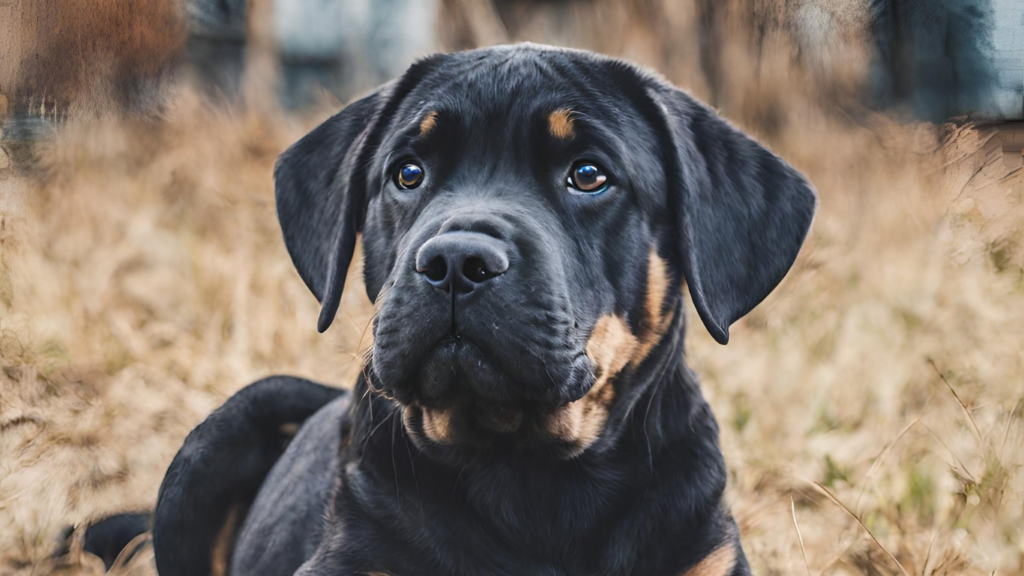The Cane Corso Rottweiler mix stands out for more than just its robust presence. Like a fireworks display on a clear night, this canine combination is a spectacle to behold. A hybrid that strikes a chord of curiosity and sometimes even controversy, the Cane Corso Rottweiler Mix (or “Corweiler”) is a newcomer in the broad palette of canine breeds. In more ways than one, this crossbred creature defies convention and sparks passionate debates among both enthusiasts and skeptics. In this fervent ode to the breed, I shall delve deep into what makes the Corso Rottweiler Mix such an intriguing, if misunderstood, four-legged friend.
Table of Contents
The Cane Corso, renowned for its Italian heritage and mastiff-like stature, and the stalwart Rottweiler, hailing from the pastoral regions of Germany, are two breeds much-revered for their protective instincts, loyalty, and imposing presence. The Cane Corso Rottweiler Mix is no less formidable. This hybrid breed carries with it a fascinating blend of its forebears’ traits while carving out its unique identity.
Personal Experience
In my interactions with the Cane Corso and Rottweiler breeds, I have been struck by their intense natural guard and protection instincts. Owners often witness a strong need in both these breeds to safeguard the family and home, which prompts a wariness of strangers. Despite this initial aloofness, there’s an unwavering loyalty and affection that develops toward their human pack in both Cane Corsos and Rottweilers.
Characteristics and Traits
The physical characteristics of the Corso-Rottweiler blend are as striking as they are varied. These dogs can inherit the muscular build and stoic presence of either parent breed, but it’s often reported that their coats are a mix of short, dense fur, sometimes adorned with unique markings. Deep-set, soulful eyes are a common trait, reflecting an intelligent and watchful nature.
Behaviorally, they’re known to be rather shrewd, trainable, and fairly unswerving. The Cane Corso Rottweiler Mix can make a notable circle of relatives puppies for knowledgeable dog proprietors who are inclined to invest time in the right socialization and training.
Training and Socialization

One of the maximum vital aspects of elevating a Cane Corso Rottweiler Mix is early socialization. These dogs require high-quality interactions with a wide sort of humans, animals, and environments from a younger age to cut down any immoderate suspicion or aggression. Positive reinforcement schooling methods, backed by using company and regular management, are noticeably effective in positively channeling their protective instincts.
Health Considerations
As with any huge breed, health is a vast problem for the Cane Corso and Rottweiler blend. Prospective owners need to be organized for potential issues with joints, such as hip or elbow dysplasia, and should screen their puppy’s weight and exercise ranges closely. Regular veterinary check-united States of America and a balanced weight loss plan are paramount to making sure of a protracted, healthy life for these gentle giants, specifically Cane Corsos and Rottweilers.
Comparative Analysis
When compared to either of its parent breeds, the Cane Corso Rottweiler Mix shares their best qualities while tending to mitigate some of their more extreme traits. While the Rottweiler can sometimes lean towards aloofness and aggression when not properly socialized, the added calm demeanor of the Cane Corso brings a welcome balance. Similarly, the Corso breed’s higher energy levels complement the Rottweiler’s more moderate exercise needs, offering a pet that’s both protective and reliable, without the need for exhaustive activities to manage their temperament.
Conclusion
The Cane Corso Rottweiler Mix challenges misconceptions about crossbred dogs and stands as a testament to the rich diversity of skills and temperaments that mixed breeds can offer. I firmly believe that, with the right owners and guidance, the Corso Rottweiler Mix makes an outstanding, loving, and protective companion. The journey with this unique crossbreed may not be the easiest, but the rewards of their unwavering loyalty and fierce affection for their pack are as boundless as their large, loving hearts.
And Are you worried about Rottweiler bites? Rottweiler Bites: What You Need To Know This article explores the causes of Rottweiler bites and offers practical tips for prevention.
FAQs About The Cane Corso Rottweiler Mix
- What is a Cane Corso Rottweiler mix? A Cane Corso Rottweiler mix is a crossbreed dog that comes from mating a Cane Corso with a Rottweiler. They are large, powerful dogs known for their strength and protective nature.
- How big does a Cane Corso Rottweiler mix get? These dogs are large breeds. Adult males can weigh between 80 and 120 pounds, while females usually weigh between 70 and 110 pounds.
- What is their temperament like? Both the Cane Corso and the Rottweiler are known for their loyalty, bravery, and protective instincts. They can be very affectionate and gentle with their families but may be wary of strangers.
- Are they good family dogs? Yes, they can be excellent family dogs when properly trained and socialized. They are protective and devoted to their families, but their size and strength mean they need an owner who can handle them.
- What kind of exercise do they need? The Cane Corso Rottweiler mix is an active breed that requires regular exercise to keep them healthy and happy. This can include walks, playtime in the yard, and mental stimulation through training and games.
- What health issues do they have? As a large breed, the Cane Corso Rottweiler mix can face potential health issues such as hip or elbow dysplasia. Regular vet check-ups and a balanced diet can help ensure a long, healthy life.
- How long do they live? The average lifespan of a Cane Corso Rottweiler mix is around 9-10 years, but with good care, they can live longer.
- Are they easy to train? Yes, both Cane Corsos and Rottweilers are intelligent breeds that respond well to training. However, their size and strength mean that training should start early and be consistent.

